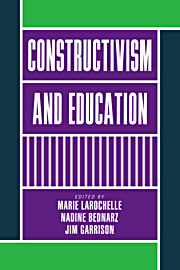Book contents
Preface
Published online by Cambridge University Press: 04 August 2010
Summary
In the past several years, the constructivist thesis has taken on a significant role in the theorizations and practices of the international education community. One can find no better evidence of this than in the now classic works operating within the Piagetian perspective. Further illustration may be found in studies of a decidedly contextual cast, which focus on the sociocognitive modes of behavior manifested in school settings, the product of the inclusion of individuals within particular groups (Gamier, Bednarz, and Ulanovskaya, 1991). Constructivism, in other words, is an umbrella term covering theorizations which are primarily centered on either the cognitive subject; the situated subject (or social actor); or the locus of knowledge, which, as Collins has stated (1990), has now become the group: “a living reminder of what it is to think and act properly” (p. 5).
This diversity of interpretations, from Piagetian constructivism to radical constructivism, or from social constructivism to sociocultural approaches, is interesting on a number of counts. Indeed, as Kuhn (1983) so convincingly showed in his study of the “life of natural sciences,” every paradigm which, at a given moment, generates the characteristic theorizations, practices, and solutions of a scholarly community also gives rise, within this same community, to a diversity of interpretations. By the same token, this absence of homogeneity constitutes one of the conditions necessary to the exercise and development of scholarly or scientific knowledge (for a telling example of this kind of exercise, see Steffe and Gale, 1995). Such diversity, however, makes it imperative to constantly redefine the conditions necessary to obtaining some sort of theoretical and empirical relevance.
Information
- Type
- Chapter
- Information
- Constructivism and Education , pp. vii - xPublisher: Cambridge University PressPrint publication year: 1998
